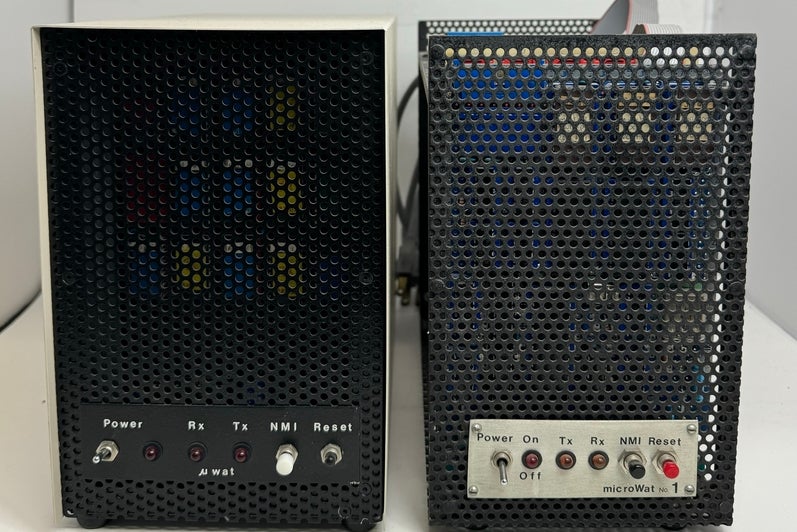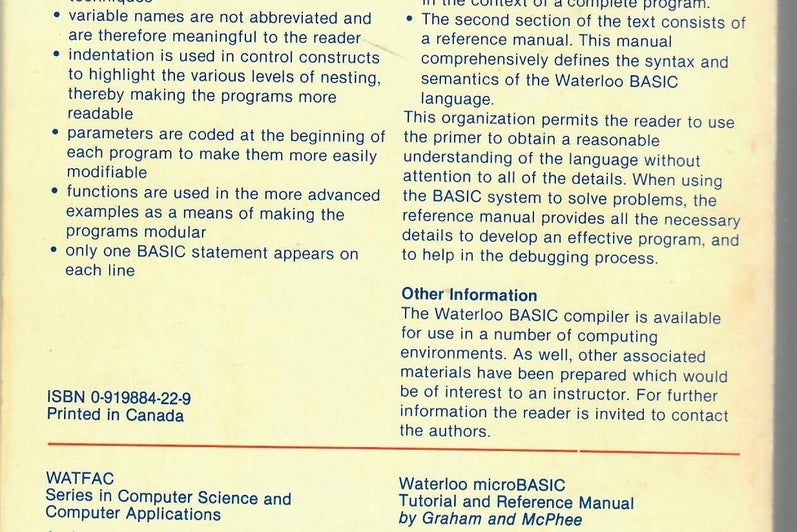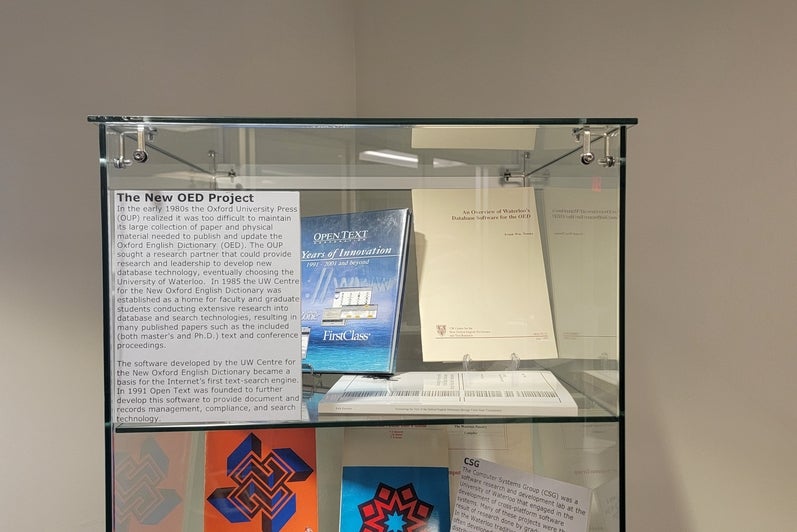New Location: After being displayed in the President's Office from March - August 2024, this exhibit has been relocated to our display case in front of DC 2935!
President's Office Exhibit
Since the mid 1960s, the University of Waterloo has been a Canadian leader in the development of computer technology for commercialization. Much of this history is well-known. Perhaps less known are the pioneering developments made by Waterloo in the evolution of computers as teaching tools.
In March 2024, the Computer Museum was invited to provide a display in the exhibit space in the President's Office. We were pleased to gather these artifacts that highlight the transition from research and innovation at the University of Waterloo to eventual commercialization.
MicroWAT
The MicroWAT was created here at the University of Waterloo to solve a teaching programming problem: too many students and not enough computers. In the late 1970s, there were plenty of relatively inexpensive personal computers, such as the Apple II, the Commodore PET, and the TRS-80. But they were also relatively underpowered for “real” programming languages like FORTRAN or APL that students needed to learn.
To address this problem, the MicroWAT was designed at the University of Waterloo with an advanced Motorola 6809 microprocessor, powerful enough for Waterloo micro languages. It was also designed to make use of Waterloo’s existing set of standard “dumb” terminals (essentially a screen and keyboard). An example of this terminal is the Volker-Craig Micro Computer, where it includes an embedded MicroWAT, providing both a computer and terminal. A CSG employee named Jerry Krist founded Northern Digital Inc (NDI) to manufacture the MicroWat, although only around one hundred of the devices were ever made.
Additionally, creating a campus wide network with the MicroWAT allowed the university to manage centrally sets of computers within classrooms. This was not previously achievable as students would need to bring in their own memory storage devices to work in the computer labs, easily allowing excuses such as "the dog ate my floppy drive".
The SuperPET used the same technology as the MicroWAT. It was created at Waterloo, built in Canada, and marketed by Commodore and sold in the thousands.
MicroWAT
Click on image to see the full picture
Volker Craig terminal with MicroWAT built-in

Waterloo Computer Museum. Volker Craig with a MicroWAT inside. 2024.
Waterloo 6809 Assembler Language
The Waterloo 6809 Assembler Tutorial and Reference guide, was published by D. D. Cowan and M. J. Shaw in 1981. The manual details the Waterloo 6809 Assembler language, one of the languages used to program the MicroWAT.
Waterloo 6809 Assembler
Click on image to see the full picture
Computer Systems Group (CSG)
The Computer Systems Group (CSG), originating at the University of Waterloo, was a software research and development lab that engaged in the development of cross-platform software systems. Many of these projects were the result of research done by graduate students. In the Waterloo tradition, these projects were developed into commercial products and distributed to other institutions, by the University itself or by other organizations.
Pictured are examples of the results of this “academic to commercial” process at the University.
The academic beginning of Waterloo BASIC was in the CSG lab, presented in the thesis An Approach to Incremental Compilation as Applied to Waterloo BASIC, published by K. Ian McPhee in 1979 and the text Waterloo Basic Primer and Reference Manual, written in 1980. Commercially, the manual IBM Series/1 Waterloo BASIC Compiler and Runtime Monitor Program Description/Operations Manual, was later distributed by IBM in 1981.
The Waterloo Pascal compiler, was developed in 1980 and distributed initially by CSG through manuals such as The Pascal Reference Manual and Waterloo Pascal User’s Guide and A Secure Implementation for the Programming Language Pascal. The language was subsequently used and distributed by WATCOM.
Waterloo Pascal
Click on image to see the full picture
Waterloo BASIC
Click on image to see the full picture
New OED Project
Before its digitization, the Oxford English Dictionary (OED) was solely available in paper form. In the early 1980s the Oxford University Press (OUP) realized it was too difficult to maintain its large collection of paper and physical material. The OUP sought a research partner that could provide research and leadership to develop new database technology, eventually choosing the University of Waterloo. In 1985 the UW Centre for the New Oxford English Dictionary was formed. Composed of faculty and graduate students, extensive research into the underlying database and search technologies was undertaken, resulting in many published papers such as the included (both master's and Ph.D.) text and conference proceedings.
The software developed by the UW Centre for the New Oxford English Dictionary became a basis for the Internet’s first text-search engine. In 1991 Open Text was founded, further developing this software to form management of documents, records, create compliance solutions, and searching technology.
OED Project
Click on image to see the full picture
Open Text
Click on image to see the full picture
Our Donors
This exhibit could not have been possible without artifact donations from Trevor R. Grove, Roy Ford, Lawrence Folland, and Frank Tompa. View the artifacts in the exhibit within our Museum Catalogue.
Photos of the President's Office Display
Photos of the President's Office Exhibit
New Location: After being displayed in the President's Office from March - August 2024, this exhibit has been relocated to our display case in front of DC 2935!

















































